Bonnie Ferrante's Blog, page 95
June 21, 2014
Brierley, Saroo. A Long Way Home. Book Review.

A Long Way Home by Saroo Brierley is the most amazing memoir I have ever read. Saroo lived in India with his mother and two siblings and no father. They survived on the mother’s meager salary and what the children could beg or steal, severely malnourished and living with less than nothing. At five years old, Saroo was often responsible for taking care of his baby sister while the rest of the family scrounged essentials. It didn’t seem possible for things to get any worse, but they did.
Through a series of events, Saroo became lost in one of the most dangerous cities in the world, Calcutta. The memoir shows us his remarkable survival and eventual adoption by an Australian couple. When Saroo was adult, Google maps became available and he began his search for his family. Saroo loved and appreciated his Australian parents but needed to know what happened to his other family. He also realized his biological mother never found out why he disappeared.
Even though the book begins with Saroo in India as an adult, seemingly on the verge of finding his mother, the reader is held in shocked suspense throughout the entire narration. What this tiny five-year-old child went through and how he survived it is unimaginable. His desire to reunite with his birth family is heart-wrenching.
The book is written in first person. The style is comfortable and the story would fascinate anyone from ages 12 to 100. I stayed up long into the night reading, unable to sleep until I knew whether he would find his birth family and who would still be alive. Highly recommended.


June 20, 2014
King, A. N. The Crabby Teacher. Book Review.
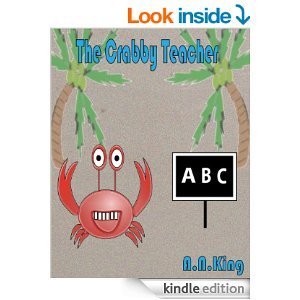
This book is written in rhyme, which is amateurish and awkward. The title, The Crabby Teacher, is misleading. The story is about a nice male crab who teaches baby crabs and then has to go away to teach other baby crabs. Because they miss him, he comes back to say hi. That is the entire story.
The illustrations are flat, simple computer graphics. The exact same figure is used over and over for the crabby teacher and other pictures are repeated as well.
Neither the story nor the illustrations are at all professional. Save your money. These kinds of books give indie publishing a bad name.
Not recommended.


June 18, 2014
Cobb, Vicki. Why Doesn’t the Earth Fall Up? And other not such dumb questions about motion. Illustrated by Ted Enik. Book Review.

Vicki Cobb has one several awards for her nonfiction science books. Why Doesn’t the Earth Fall Up? is another great one. Nine questions about motion are posed. Background information is given. Each chapter ends with a science experiment the children can do themselves which will provide the answer. Most of the materials are easy to obtain.
This book would make a great addition to a junior classroom studying motion. I think it would have benefited from a list of materials for each experiment. The reader has to skim through to find out what is needed.
Some of the experiments will produce surprising results, such as “Which takes longer, a big, high swing or small, low swing?” There are fun illustrations of children investigating.
The index at the back lists scientists mentioned in the text as well as bodies of space and scientific concepts.
Well recommended.


June 16, 2014
Calmenson, Stephanie. The Principal’s New Clothes. Illustrated by Denise Brunkus. Book Review.
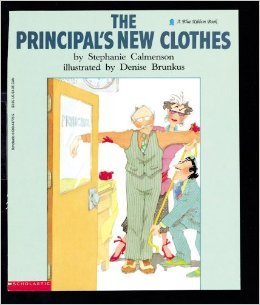
I love when an author and illustrator can update a traditional fairy tale and make it connect better with contemporary children. Calmenson and Brunkus have succeeded beautifully. Instead of a vain emperor, we have a clothes crazy principal. The two con artists, Ivy and Mo, appeal to the principle’s vanity. As in the traditional story, they pretend to create clothes that are invisible to anyone who is unfit for their job or is stupid. Everyone is afraid to confess they cannot see the cloth. The vice principal Ms. Moore, Roger the smart student, and finally the principal himself all pretend they can see fabric where none exists. When the principal walks to school and into the auditorium in his underwear, a kindergarten child, Alice, cries out, “The principal’s in his underwear!”
Here the author adds a special touch of her own. Instead of continuing to mock the foolish principal, the teachers and students provide him with shirts, sweatpants, and other clothing. Alice is rewarded with a gold star for telling the truth. Everyone agrees that Mr. Bundy is “still the sharpest dresser in town” even though his clothes are mismatched and ill fitting, especially the small pink sweatpants.
I love the idea that when someone makes a mistake, instead of making them feel worse, we have the option of supporting them with kindness.
Denise Brunkus’s illustrations are fun and expressive. But, I thought the smartest child in the school was unnecessarily clichéd.
It isn’t often that I can say I like an updated version of a fairytale better than the original. Highly recommended.


June 13, 2014
Stutson, Caroline. Cats Night Out. Illustrated by J. Klassen. Book Review.
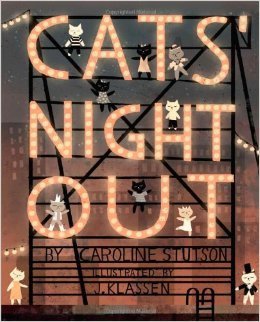
This book is filled with cool cats. It begins, “From the alley, music drifts. Shadows sway to a trumpet riff thought…” The dark city is lit up by Jazz sign as music notes drift through the air. Shows two cats dancing on a rooftop. “Two cats somber, dressed in white, on the rooftop Saturday night.” Each page continues in this pattern. Four cats boogie, six cats tango, eight cats tap, and so on. Each pair of cats dances in a different style and wears appropriate clothing. There are poodle skirts, red capes, bowler hats, and rhinestone boots. The rhyming couplet keep the beat. Cool cats are everywhere, fire escapes, heat exhaust pipes, streetlight poles, and more. Three times, Caroline Stutson writes, “In the city, Windows light. How many cats will dance tonight?” Finally the humans protest and the cats slip away. But the next night, music drifts on Easy Street and two cats waltzing in black half masks begin the Cats Night Out.
The illustrations by J. Klassen are done in gray, black, and brown with muted touches of color. They bring to mind the smoky, dark interiors of jazz bars. Every cat is completely lost in the dance.
Although there are a couple of tiny glitches in the beat of the rhyming couplets, this is a delightful book to read aloud. Any child who loves the mischievous nature of cats or is interested in dance will enjoy this book. A fun book that will be read more than once.
Highly recommended.


Temple, Hollee. ABC Animals – Mammals. Photographs from Wikipedia photographers. Book Review.

On each page is the name of an animal, a photograph taken from the Internet, and a statement crediting the photographic source. There is no other information on the page at all. At the end of the book is a short definition of a mammal. This is followed by links to other resources online.
I’m not really sure what age this book is intended for as the photographs would not hold the interest of a very young child and the content would not hold the interest of an older child. It might have been a worthwhile book if some information about each animal had been included especially as it pertains to their mammal classification.
Not recommended.


June 11, 2014
Underwood, Deborah. A Balloon for Isabel. Illustrated by Laura Rankin. Book Review.
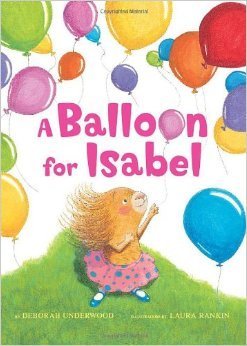
This book starts with a great hook. Isabel and Walter, two little porcupines, are protesting an unfairness done to them two days before graduation. Because they are covered in quills, Isabel and Walter will not be presented with balloons. They are tired of receiving bookmarks. (The skunks, raccoons, mice, foxes, and other characters appear to be kindergarten age.)
Walter and Isabel attempt several strategies to change the teacher’s mind. The teacher is also a porcupine and has logical reasons why they should not be given balloons. Walter and Isabel refuse to give up their dream. They discuss the special characteristics of balloons and why they each want one so badly. After several failed attempts, Walter and Isabel succeed and are rewarded with the longed for red and green balloons.
Many children will identify with Isabel. It is deeply frustrating to be told you can’t have something because you’re different than everyone else. Isabel and Walter’s determination, problem-solving, and creative thinking are inspiring. The happy ending is well earned.
Laura Rankings illustrations are bright and charming. Readers will laugh at the porcupine’s expressions and their attempts to become pop – proof.
Highly recommended.


June 8, 2014
Gordon, Scott. Froggy Dearest. Illustrations by Sebastian Kaulitzki, Konstantin Grishin, and Julien Tromeur. Book Review.

In this book, the frog speaks directly to the reader as the object of his affection. He tries to convince the reader of his worth as a sweetheart. All he wants is a kiss. This will turn him back to the fierce king he once was. Through promises and flattery he does convince the object of his affection to kiss him transforming him into… Well, I wouldn’t want to ruin the surprise.
The author says that this book was originally written for children aged 3 to 6, but he changed his mind and now recommends it for parents to read to their children. Even so, I would say it was for older children than that. Some of the vocabulary such as “token”, “lowly”, “latte – caramel macchiato” “multiplex”, “stereoscopic”, “angelic”, “vibrant”, and “radiating” would be too difficult for a child under 11 years old. An expressive parent of a child between the ages of seven in 10 might be able to get across the context without too much stopping and explaining. Most children would be unable to read it by themselves, even after hearing it once, not only because of the vocabulary but because the text is a fancy script. I actually think this book would be enjoyed by tweens and up the most.
The illustrations are amazing. The three-dimensional digital drawings look like they stepped right out of a Pixar movie. The frog is adorable. I did find the pictures somewhat bare after a while.
Well recommended, but not really for children.


June 6, 2014
Gold, Chaim. Nick and Panicky Rabbit – How to Conquer Panic. Book Review.
This book is published by Educational Knowledge Resources and is part of a series on teaching kids feelings and emotions. As this is not a book for entertainment or reading pleasure, this book review will discuss the text in relation to its proposed purpose.
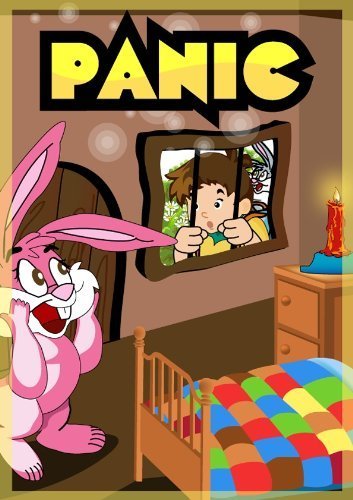
At school, the teacher discusses disaster preparation. They have a practice fire drill and the teacher tells them, “the important thing is that you should never panic. Once you panic, you are no longer able to think clearly.” Before she can explain what the word panic means, the school bell rings. On the bus on the way home, Nick dreams that he is approached by a rabbit who is in a panic. The rabbit has left a candle burning in his home and is sure his house is on fire, together, they check through the window and see that the candle was snuffed out before the rabbit left. Nick wakes up, exits the bus, and finds a bunch of carrots by his front door.
In this story, the body’s reaction to panic is explained. Nick learns to close his eyes for a few seconds and take deep breaths to calm himself. When he and the rabbit discover that the house was not on fire after all, they reiterate that “once you panic, you can no longer think clearly.”
This book would be best used by a parent helping a child to cope with strong emotion, or classroom teacher explaining how to handle an emergency situation. I would’ve liked a little more explanation on how to control panic. Some of the text could have been trimmed down. For example, we didn’t need to know that Nick lived in a small town and was a very smart boy. I was also surprised to see that a book published in 2013 used the sexist term “firemen”.
The illustrations were bright and cute, much like a Disney book. It took me a moment to understand that the rabbit turning from gray to pink was meant to represent embarrassment. A stronger use of humor would have made the story more palatable.
This book could be a useful addition to a discussion when dealing with panic. Recommended.


June 5, 2014
5 Tips for writing reviews
So, you want to write a review.
Should you summarize the story?
Should you give a personal opinion?
Should you critique the writing style?
Ashley LaMar explains the five things to remember:





